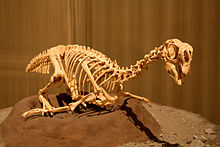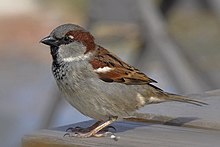No edit summary |
Trilletrollet (talk | contribs) removed Category:Maniraptorans; added Category:Coelurosaurs using HotCat |
||
| (48 intermediate revisions by 33 users not shown) | |||
| Line 1: | Line 1: | ||
{{Short description|Clade of dinosaurs}} |
|||
| ⚫ | |||
{{Merge to|Maniraptora|date=April 2024}} |
|||
| fossil_range = <br>[[Late Jurassic]]–[[Holocene|Present]], {{Fossil range|160|0}} |
|||
{{Automatic taxobox |
|||
| ⚫ | |||
| ⚫ | |||
| ⚫ | |||
| taxon = Pennaraptora |
|||
| fossil_range = <br />[[Middle Jurassic]]–[[Holocene|Present]], {{Fossil range|165|0|ref=<ref>{{cite journal | last1 = Zhang | first1 = H. | last2 = Wang | first2 = M. | last3 = Liu | first3 = X. | year = 2008 | title = Constraints on the upper boundary age of the Tiaojishan Formation volcanic rocks in West Liaoning-North Hebei by LA-ICP-MS dating | journal = Chinese Science Bulletin | volume = 53 | issue = 22| pages = 3574–3584 | doi = 10.1007/s11434-008-0287-4| bibcode = 2008SciBu..53.3574Z }}</ref>}} |
|||
| ⚫ | |||
| ⚫ | |||
| image2 = Passer domesticus male (15).jpg |
| image2 = Passer domesticus male (15).jpg |
||
| image2_caption = [[House sparrow]] (''Passer domesticus'') |
| image2_caption = [[House sparrow]] (''Passer domesticus'') |
||
| display_parents = 2 |
|||
| authority = Foth ''et al.'', 2014 |
| authority = Foth ''et al.'', 2014 |
||
| subdivision_ranks = Subgroups |
| subdivision_ranks = Subgroups |
||
| subdivision = |
| subdivision = |
||
* {{extinct}}''[[Yixianosaurus]]'' |
|||
* {{extinct}}[[Oviraptorosauria]] |
* {{extinct}}[[Oviraptorosauria]] |
||
* {{extinct}}[[Scansoriopterygidae]]<br>(''[[incertae sedis]]'') |
|||
* [[Paraves]] |
* [[Paraves]] |
||
| synonyms = *'''Aviremigia''' <small>[[Jacques Gauthier|Gauthier]] and [[Kevin de Queiroz|de Queiroz]], 2001</small> |
|||
}} |
}} |
||
| ⚫ | '''Pennaraptora''' (Latin ''penna'' "bird feather" + ''raptor'' "thief", from ''rapere'' "snatch"; a feathered bird-like predator) is a [[clade]] defined as the most recent common ancestor of ''[[Oviraptor philoceratops]]'', ''[[Deinonychus antirrhopus]]'', and ''[[Passer domesticus]]'' (the house sparrow), and all descendants thereof, by Foth ''et al.'', 2014.<ref name=foth_archaeopteryx>{{cite journal | doi = 10.1038/nature13467 | title=New specimen of Archaeopteryx provides insights into the evolution of pennaceous feathers | journal=Nature | date=2014 | volume=511 | issue=7507 | pages=79–82 | first1=Christian | last1=Foth | first2=Helmut | last2=Tischlinger | first3=Oliver | last3=Rauhut | pmid=24990749}}</ref> |
||
| ⚫ | The clade "Aviremigia" was conditionally proposed along with several other [[Synapomorphy and apomorphy|apomorphy]]-based clades relating to [[bird]]s by [[Jacques Gauthier]] and [[Kevin de Queiroz]] in a 2001 paper. Their proposed definition for the group was "the clade stemming from the first [[Panaves|panavian]] with ... [[remiges]] and [[rectrices]], that is, enlarged, stiff-shafted, closed-vaned (= barbules bearing hooked distal pennulae), pennaceous feathers arising from the distal forelimbs and tail".<ref name="gauthier&dequeiroz2001">Gauthier, J. and de Queiroz, K. (2001). "Feathered dinosaurs, flying dinosaurs, crown dinosaurs, and the name 'Aves'". Pp. 7-41 in Gauthier, J. and L.F. Gall (eds.), ''New Perspectives on the Origin and Early Evolution of Birds: Proceedings of the International Symposium in Honor of John H. Ostrom''. New Haven: Peabody Museum of Natural History, Yale University. {{ISBN|0-912532-57-2}}.</ref> Ancestral morphology relating to pennaceous feathers suggests that basal species of Pennaraptora were capable of scansorial locomotion and gliding, and further evolution of said adaptation within the clade would eventually give rise to the origin of flight in avian species.<ref>{{Cite journal |last=Sorkin |first=Boris |date=2021-12-02 |title=Scansorial and aerial ability in Scansoriopterygidae and basal Oviraptorosauria |url=https://doi.org/10.1080/08912963.2020.1855158 |journal=Historical Biology |volume=33 |issue=12 |pages=3202–3214 |doi=10.1080/08912963.2020.1855158 |issn=0891-2963}}</ref> |
||
| ⚫ | '''Pennaraptora''' is a [[clade]] defined as the most recent common ancestor of ''[[Oviraptor philoceratops]]'', ''[[Deinonychus antirrhopus]]'', and ''[[Passer domesticus]]'' (the house sparrow), and all descendants thereof, by Foth ''et al.'', 2014.<ref name=foth_archaeopteryx>{{cite journal | doi = 10.1038/nature13467 | title=New specimen of Archaeopteryx provides insights into the evolution of pennaceous feathers | journal=Nature | date=2014 | volume=511 | issue=7507 | pages=79–82 | |
||
==See also== |
|||
| ⚫ | The clade "Aviremigia" was conditionally proposed along with several other apomorphy-based clades relating to [[bird]]s by [[Jacques Gauthier]] and [[Kevin de Queiroz]] in a 2001 paper. Their proposed definition for the group was "the clade stemming from the first [[Panaves|panavian]] with ... remiges and rectrices, that is, enlarged, stiff-shafted, closed-vaned (= barbules bearing hooked distal pennulae), pennaceous feathers arising from the distal forelimbs and tail".<ref name="gauthier&dequeiroz2001">Gauthier, J. and de Queiroz, K. (2001). "Feathered dinosaurs, flying dinosaurs, crown dinosaurs, and the name 'Aves'". Pp. 7-41 in Gauthier, J. and L.F. Gall (eds.), ''New Perspectives on the Origin and Early Evolution of Birds: Proceedings of the International Symposium in Honor of John H. Ostrom''. New Haven: Peabody Museum of Natural History, Yale University. ISBN |
||
*[[Evolution of birds]] |
|||
*[[Origin of avian flight]] |
|||
*[[Origin of birds]] |
|||
==References== |
== References == |
||
{{ |
{{Reflist|25em}} |
||
{{Maniraptora|M.}} |
|||
{{Birds}} |
|||
{{Fins, limbs and wings}} |
|||
{{Taxonbar|from=Q4828939}} |
|||
{{Portal bar|Birds|Dinosaurs|Evolutionary biology|Paleontology}} |
|||
[[Category:Coelurosaurs]] |
[[Category:Coelurosaurs]] |
||
[[Category:Extant Late Jurassic first appearances]] |
|||
{{ |
{{Theropod-stub}} |
||
Revision as of 12:48, 23 April 2024
| Pennaraptorans | |
|---|---|

| |
| Cast skeleton of Conchoraptor gracilis | |

| |
| House sparrow (Passer domesticus) | |
| Scientific classification | |
| Domain: | Eukaryota |
| Kingdom: | Animalia |
| Phylum: | Chordata |
| Clade: | Dinosauria |
| Clade: | Saurischia |
| Clade: | Theropoda |
| Clade: | Maniraptoriformes |
| Clade: | Maniraptora |
| Clade: | Pennaraptora Foth et al., 2014 |
| Subgroups | |
| Synonyms | |
| |
Pennaraptora (Latin penna "bird feather" + raptor "thief", from rapere "snatch"; a feathered bird-like predator) is a clade defined as the most recent common ancestor of Oviraptor philoceratops, Deinonychus antirrhopus, and Passer domesticus (the house sparrow), and all descendants thereof, by Foth et al., 2014.[2]
The clade "Aviremigia" was conditionally proposed along with several other apomorphy-based clades relating to birds by Jacques Gauthier and Kevin de Queiroz in a 2001 paper. Their proposed definition for the group was "the clade stemming from the first panavian with ... remiges and rectrices, that is, enlarged, stiff-shafted, closed-vaned (= barbules bearing hooked distal pennulae), pennaceous feathers arising from the distal forelimbs and tail".[3] Ancestral morphology relating to pennaceous feathers suggests that basal species of Pennaraptora were capable of scansorial locomotion and gliding, and further evolution of said adaptation within the clade would eventually give rise to the origin of flight in avian species.[4]
See also
References
- ^ Zhang, H.; Wang, M.; Liu, X. (2008). "Constraints on the upper boundary age of the Tiaojishan Formation volcanic rocks in West Liaoning-North Hebei by LA-ICP-MS dating". Chinese Science Bulletin. 53 (22): 3574–3584. Bibcode:2008SciBu..53.3574Z. doi:10.1007/s11434-008-0287-4.
- ^ Foth, Christian; Tischlinger, Helmut; Rauhut, Oliver (2014). "New specimen of Archaeopteryx provides insights into the evolution of pennaceous feathers". Nature. 511 (7507): 79–82. doi:10.1038/nature13467. PMID 24990749.
- ^ Gauthier, J. and de Queiroz, K. (2001). "Feathered dinosaurs, flying dinosaurs, crown dinosaurs, and the name 'Aves'". Pp. 7-41 in Gauthier, J. and L.F. Gall (eds.), New Perspectives on the Origin and Early Evolution of Birds: Proceedings of the International Symposium in Honor of John H. Ostrom. New Haven: Peabody Museum of Natural History, Yale University. ISBN 0-912532-57-2.
- ^ Sorkin, Boris (2021-12-02). "Scansorial and aerial ability in Scansoriopterygidae and basal Oviraptorosauria". Historical Biology. 33 (12): 3202–3214. doi:10.1080/08912963.2020.1855158. ISSN 0891-2963.










